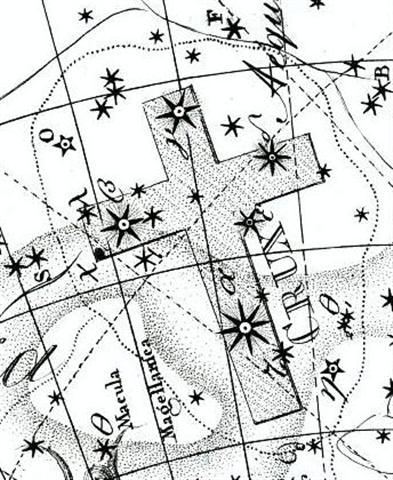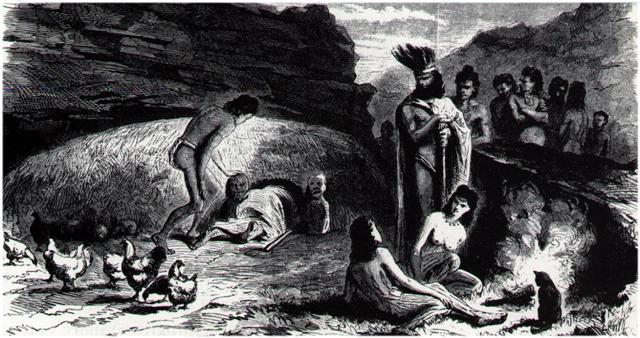Ba4.1 The 4th line could have been regarded as unlucky: ... Interestingly, since another meaning of shi is 'death', the number 4 is considered unlucky. (For example, the floor numbering in hotels sometimes jumps mysteriously from 3 to 5; it's also considered unlucky to give four of something as a present.) After 4 weeks the Moon 'dies' (●). Although this was only a temporary situation: ... When the new moon appeared women assembled and bewailed those who had died since the last one, uttering the following lament: 'Alas! O moon! Thou has returned to life, but our departed beloved ones have not. Thou has bathed in the waiora a Tane, and had thy life renewed, but there is no fount to restore life to our departed ones. Alas ... In the Southern Cross the idea was connected with the star Mimosa (β Crucis) - at the 4th limb of Crux (counting clockwise from γ at the top):  Rau hei. 1. Branch of mimosa. 2. Killed enemy. 3. Hanged 'fish'. 'Branche du mimosa (signe de mort), ennemie túe (poisson suspendu)' according to Jaussen. Barthel.
Ba3-31 (→ 3 31, the last day in March) has a picture of a 'hanging victim' (rau hei). ... Across the bows connecting each double canoe was a floor, covering the chambers containing idols, drums, trumpet shells, and other treasures for the gods and people of Ra'itea; and upon the floor were placed in a row sacrifices from abroad, which consisted of human victims brought for that purpose and just slain, and great fishes newly caught from fishing grounds of the neighboring islands. They were placed upon the floor, parallel with the canoe, alternatively a man and a cavalli fish, a man and a shark, a man and a turtle, and finally a man closed in the line. Behind this grim spectacle stood two or three priests in sacerdotal attire, which consisted of a plain loin girdle, a shoulder cape reaching down to the waist and tipped with fringe, wide or narrow according to their grades, and a circular cap fitting closely to the head - all made of finely braided purau bark bleached white. Seated at the paddles were the navigators and warrior chiefs in gay girdles and capes of tapa and helmets of various shapes, and wise men in plain girdles, capes, and turbans of brown or white tapa. As this terribly earnest procession arrived, the canoes were quietly drawn up along the shore, and the guests were met at the receiving marae by an imposing procession of the dignitaries and warriors of the land grandly attired, and also unarmed [cfr Alaraph, β Virginis], headed by the king, the two primates, Paoa-uri and Paoa-tea, and the priests of the realm, who greeted them in low, solemn tones. Then everybody alike set to work silently disposing of the sacrifices just arrived, combined with others of the same mixed kind prepared by the inhabitants of the land. They strung them through the heads with sennit, and act called tu'i-aha, and then suspended them upon the boughs of the trees of the seaside and inwards, the fish diversifying the ghastly spectacle of the human bodies, a decoration called ra'a nu'u a 'Oro-mata-'oa (sacredness of the host of Warrior-of-long-face) ... In the Golden Age of the Bull the star β Crucis
should have been possible to observe in (the night of) day number 192 + 200 = 392 (equal to the number of glyphs on side a of the C text) = 366 (= 370 - 4) + 26 (= 30 - 4).
Day 26 + 64 (the precessional time depth down to the Golden Age of the Bull) = 90 = March 31. Next day was April 1 (91) when Legs became necessary - for how else would it be possible to travel upon dry land (Terra Firma)?
... During his descent the ancestor still possessed the quality of a water spirit, and his body, though preserving its human appearance, owing to its being that of a regenerated man, was equipped with four flexible limbs like serpents after the pattern of the arms of the Great Nummo. The ground was rapidly approaching. The ancestor was still standing, his arms in front of him and the hammer and anvil hanging across his limbs. The shock of his final impact on the earth when he came to the end of the rainbow, scattered in a cloud of dust the animals, vegetables and men disposed on the steps. When calm was restored, the smith was still on the roof, standing erect facing towards the north, his tools still in the same position. But in the shock of landing the hammer and the anvil had broken his arms and legs at the level of elbows and knees, which he did not have before. He thus acquired the joints proper to the new human form, which was to spread over the earth and to devote itself to toil ... Glyph line Ba4 is not beginning where we could have expected, viz. at a place corresponding to April 1 (91). Instead there are 6 days added at the end of line Ba3 (after Mimosa).. Possibly the Metoro term te tauuru could help us understand why: ... The low entrances of houses were guarded by images of wood or of bark cloth, representing lizards or rarely crayfish. The bark cloth images were made over frames of reed, and were called manu-uru, a name given also to kites, masks, and masked people ...
|
|||||||||||||||||||||||||||||||||||||||||||||||||||||||||||||||||||||||||||||||||||||||||||||||||||||||||||||||||||||||||||||











